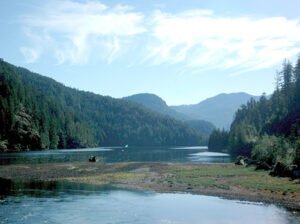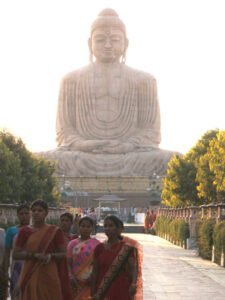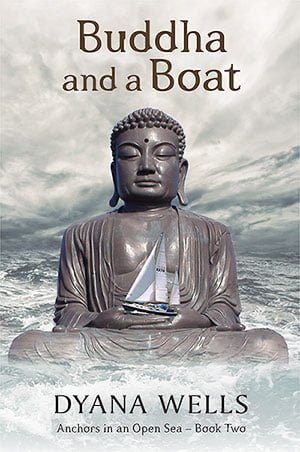Galiano Island is a wild slip of land grown up between mainland Canada and Vancouver Island. Punyashri and I arrived by ferry, an hour’s journey, ploughing through dark space and water, getting closer, excitement rising; we were almost there. Our New Zealand lives were now thirty hours behind. Libby, a fellow student, met us at the wharf and I finally breathed out, long and deep. She loaded our heavy luggage into her four-wheel drive and we drove the backbone of the island, slowing only to let the deer cross. White tails flashed and plunged back into the dark.

Galliano seal
I smiled some more as I poked around my centrally-heated, luxurious (by retreat standards) meditation home. Forest was all around. The firewood was cedar, spruce, fir and arbutus. The big eyes of the house looked out over Trincomali Channel, where otters and seals and pods of whales froliced and fed just below. The hills of Vancouver Island across the water gathered the sun down into flamboyant sunsets and the snow fell and melted throughout the retreat, as the warm ocean currents from Japan and the warmer air currents from Hawaii, took turns with colder weather systems pouring down from the Arctic.

Galliano beaver ponds
I watched the beaver ponds freeze up under snowy trees and melt again. I watched small beavers at dusk, swimming through their domain and feeding in the mud close to shore. Their dams are turning large belts of cedar forest into swamp. Rotting tree skeletons fall regularly with loud thwacks when the winds rush at them. I came across at least twenty freshly-beaver-felled saplings, awaiting the spring floods for the beavers to move them to a new dam site on Crystal Mountain.
Abhidhamma – it’s tricky to describe just what this is. Our commentary, the Abhidhammathasangaha says ‘Buddhist philosophy and psychology’. Lama Mark said, incorrect, ‘an Insight manual for professional yogins, a brilliant Insight manual’. The original Abhidhamma, is said to be the direct teaching of the Buddha, but clearly not all of it is. It was quite a challenge. We poured over our Sanskrit and Pali dictionaries, unraveling the roots for clues about the ultimate realities of experience.
Here goes. In Abhidhamma there are four ultimate realities. The first three – consciousness, mental factors and matter – are conditioned; the fourth, Nibbana, is unconditioned. We seem to be mainly studying the conditioned realities. There are 121 states of consciousness, categorized as wholesome, unwholesome, sublime, functional and transcendent, and 52 mental factors including will, desire, one-pointedness, tranquillity, shame,greed, compassion etc. The third conditioned reality, ‘rupa’ or ‘matter’, can’t be experience directly, because all experience is mediated by concepts. However, the fundamental rupas, the mahabutas (earth, air, fire and water), are experienced directly. I couldn’t work that one out.
The fourth ultimate reality, Nibbana, the unconditioned, is only experienced in a path-moment, in a fraction of a second, although the Fruition moments (Phala) that feel like the path moments are many, and last longer (or apparently so). They can happen sometimes off and on, for the rest of a being’s lifetime, and are the direct experience of the cessation of clinging. Nibbana is defined as the absence of greed, hatred and delusion. Now this is where it gets confusing. Self is not discussed directly in the Abhidhamma as it has no ultimate reality, however many states of consciousness, which are ultimately real, are rooted in a self eg. greed, hatred, delusion and their opposites, and many of the mental factors are complex and are also built around a self. Kamma, which is discussed in depth,is also built by a self. Animals don’t accrue kamma. Our teacher said the Buddha neither denied nor asserted the existence of a self. I would have to discover the truth for myself, through insight

Galliano Island forest
Mornings, we walked through the forest past the beaver dams up the hill to Lama Mark’s new home, a large Tibetan/Austrian, temple-like abode, with beautiful carpets, brocade chairs, art work, minerals and ornaments all around. It has both a laboratory and a shrine room. Many times we stayed on for coffee and analysed the latest blend. Eighty per cent Papa New Guinean and twenty per cent Ethiopian. Hmmm. Sometimes the coffee tasted of almonds, sometimes of creosote or chocolate. It could be sweet or sour, full of high notes or low notes. And we watched the junkos and chickadees outside at the bird feeder. Then the coffee roaster arrived! Discrimination, mindfulness and etiquette were blended skillfully by Lama Mark into the sublime and the humorous.
The forest abounded in wild mushrooms. Under the trees by the road they were as large as dinner plates. No good for eating though. I plucked some lobster mushrooms, big as a small lobster but curled like a misshapen ear, and bright orange, because a hard, orange fungus has crawled all over them Every day until it snowed, Shelane, Barrie and I arrived home with new specimens. Libby, the expert, said yes or no. We cooked the yes’s slowly with garlic, salt and butter. Delicious. Libby shared Chanterelle with us, and Anya distributed her basketful of White Pine mushrooms. Eighty dollars per kilo on the open market!
Lama Mark quoted, one moment from the text, the next from the texts of famous Zen-Hwa Yen masters, or from the Kalacakra-tantra, and from teachings of Namgyal Rinpoche, then from books on neuroscience or a recent experiment in psychology précised in a recent New Scientist. One day the tree existed even when no one was looking at it, the next week it didn’t. How could it? Tree is a concept. One day the whole universe was nothing but clinging, the next day freedom lay in the absence of clinging.
The Abhidhamma model of the cognitive process posits a repetitive series of 17 discrete, linear mind moments, each 1/ 47,000th of a second long. Cognition is the dance of the bhavanga (the storehouse and base operating system of mind), the senses and matter. When they come together the 1/47,000th of a second individual mind moments arise and fall in sequence. En masse, voila. We would have to slow way down to directly observe the process … way, way down. Lama Mark told us many times that experiencing the cognitive process at the micro-momentary level—paying very close attention—breaks apart the formation, the illusion and brings forth Insight.
To keep our minds open and pliable, Lama Mark invited us up for regular movie evenings. We laughed and debriefed through ‘The Love Guru’, ‘Wayne’s World’, ‘The Prisoner’, ‘The Matrix’ and ‘Inception’.

Galliano raccoons
The raccoons came visiting at my house. I trained Ruby, Rudy, Robin and Rose to wait their turn for the dog biscuits and other scraps I held out. I enticed them inside with biscuits trailing across the carpet. I studied their habits as I reflected on the human hallucination. Sunny days, I meditated on the rocks outside. Deer rested and browsed just below. Squirrels skittered past with their cones, again and again, one cone at a time. I knew when a whale arrived from the noise of water spouting.
Evenings, we gathered for class in front of an open fire, in the house I shared with Barry and Shelane. Large thangkas on the wall and a white marble Buddha – with a plush, golden-pillow halo, atop an altar of eight offering bowls – infused our minds with reverence and respect as we awaited the arrival of Lama Mark and his attendants. And through the confusing richness our minds slowly turned and wandered and tuned themselves to what lay beyond and behind and within the vast panorama of life. I’m not sure any of us knew what was going on initially, we were too busy, we just trusted the process. What else could we do? We hooked ourselves up to the mind of the Lama and let go.
We were in class five-six hours a day. The laboratory work and group work was extra. We carefully poured sulphuric acid through a labyrinth of clamped glass tubing into a glass flask of bleach, and produced chlorine gas – yellow as daffodils. Chlorine is an element in the periodic table, a Mahabuta of modern science. We grew crystals on threads from a super-saturated solution of Epsom salts. We put menstrual blood and sperm under the microscope, to see in detail the nature of the fluids frothing from the skull cups of tantric deities, and we extracted pure DNA, seeds of karma, from cheek cells. We became like medieval alchemists, boiling and decanting, distilling and blending our lump of lead, looking for gold. The ancients couldn’t do it but they got wise on the way.
The Abhidhamma reduces experience to mind moments. We reduced mind states to chemistry. No self in either, of course. Calm and bliss arise from a precise cocktail of hormones, mediated by the mind. Meditation manipulates the hypothalamus (and other parts of the brain-body) according to the recipe.
We rushed onwards. Mind and matter are linked in our experience, moment by moment. Nama-rupa: naming the form, forming the name. Lama Mark warned about the peril of blending them together and becoming conceptually trapped in a world of pure mind, but when he raised his hand he said, you are raising a concept, your experience is mental. The pendulum swung erratically from conventional belief in the concrete reality of chairs and hands to the absolute denial of any reality beyond experience; it hovered above the union of nama with rupa and the shivering convergence of space and mind. Again and again he pointed out the necessity of Insight, to clearly distinguish consciousness from matter, moment by moment, and not confuse the two.

Galliano orcas
I looked outside, at the faded Tibetan flags, tossing under the swaying trees. Are they really moving or is it only the concept of flag that is moving? I looked deep into the Abhidhamma. Is the movement most accurately described as a recombination of the air and earth Mahabutas? I paused to reconsider. Maybe it is only the mind that moves, or not even this; maybe the flag is merely a flickering pattern of light in the mind? I sipped my coffee again, this time a dark Columbian roast. Is there a correct answer? I smiled and let it go.
We gathered in the afternoons, stretched out on the Persian-style carpet, to share and compare our dictionary work. Words sometimes broke apart in different ways, into different roots. The evolution of language, like the Abhidhamma, isn’t clear-cut and logical, even though I thought it might be. To great yogin scholars, the Abhidhamma has always held up to refined logic, but then they were insight specialists. On the surface, I found it an uncomfortable, contradictory mix, roughly stitched together from different sources.
In the end it was the perceived conceptual contradictions that liberated me. Part of my mind is ruthlessly logical. However humans are irrational and all concepts are partial view. Truth isn’t a concept. I understood why the Buddha never got caught up in metaphysics. What would he have made of the two thousand years of tortuous argument and profound commentary, wrestling and growing an ontological and epistemological monument for his teachings? .Lama Mark said that as a training in contemplation the Abhidhamma is superb. Western psychologists and philosophers have been ‘mining’ the Abhidhamma for decades, with good results. Schopenhauer, a favourite Western philosopher of mine, probably studied the Abhidhamma. We had only scratched the surface.
 The Buddha incontestably taught the four noble truths: the fact of suffering, the cause of suffering, the cessation of suffering and the path leading to the cessation of suffering. The Abhidhamma defines the ultimate irreducible ingredients of human experience. It analyses them cleanly so their impermanence, their unsubstantiality and their lack of any inherent self stand out like dogs’ balls. The Abhidhamma is the foundation of the four noble truths.
The Buddha incontestably taught the four noble truths: the fact of suffering, the cause of suffering, the cessation of suffering and the path leading to the cessation of suffering. The Abhidhamma defines the ultimate irreducible ingredients of human experience. It analyses them cleanly so their impermanence, their unsubstantiality and their lack of any inherent self stand out like dogs’ balls. The Abhidhamma is the foundation of the four noble truths.
After three months of intense study I gasped, then plunged into the freedom of the final month, a deep insight retreat. No classes, just interviews. I sat through bliss and boredom, just noting, following the breath, rising and falling, no self in the boredom, no self in the excruciating sense of oppression, impermanence in every breath, confabulation in every memory, noting the clinging, the determination to give birth to a self, minutes stretching into hours. Lama Mark was ready with his scalpel when I surfaced for my interviews. He sliced the bliss and clarity of samatha (tranquillity) from Insight, bare Insight, the rise and fall of the breath. Look directly at the breath. How does it break up? What happens at the end of the breath? He didn’t want to hear about anything else. No stories. Only direct experience. Dong with the cudgel if I dared. Note in particular the end of every movement. Left foot raising, lifting, moving, lowering, touching, placing. Nothing else. Bash with the wooden club if I forgot. Seventeen paces towards the fireplace, standing, turning, standing. Seventeen paces back towards the kitchen. Slowing down, getting a bit wobbly, snow falling, wood pecker at the feeder, squirrel running past, fridge starting up, drier stopping, clock ticking, clock ticking. What happens in the gaps between the in-breath and out-breath? Lama Mark’s arrow pierces a stubborn resistance and suddenly it is all so obvious. Insight leaps into another little footstep on the path of waking up.
Boxes of food continued to arrive every week, like endless Christmas gifts: apples and pomegranates, organic brie and millet, large soft dates and of course, the coffee. Forty-ninth Parallel was my favourite, sweet and slightly chocolatey. Whatever we ordered, popcorn or shrimp kebabs, it arrived in a box, left at the front door. As part of this four month experiment, we got to choose the food we needed or just wanted. It was almost all organic. We were instructed to observe how different foods affected our energies and mental states. Nama-rupa. Mind choosing the food, food shaping the mind.
 I was counting down near the end, and when it arrived I didn’t want it. I was ready to plunge into a vast, inner universe, and un-spiral the mystery. My space-ship mind had become like a great intelligent telescope, finely polished, highly magnified, acutely focused. I had a glimpse of what was possible, a taste of further explorations just out of reach, and that glimpse, why it was worth the entire retreat.
I was counting down near the end, and when it arrived I didn’t want it. I was ready to plunge into a vast, inner universe, and un-spiral the mystery. My space-ship mind had become like a great intelligent telescope, finely polished, highly magnified, acutely focused. I had a glimpse of what was possible, a taste of further explorations just out of reach, and that glimpse, why it was worth the entire retreat.
Now I’m back home I realize that any fool can do a retreat. What matters is whether I can allow insight to transform my experience back here. Can I hold enough space to let changes in perception mature ? Can I keep one foot up while the other foot steps firmly down into the matrix?
Thank you Lama Mark, for your outstanding skill, compassion, and dedication to the welfare of all beings. To everyone who gave so generously of their time, money and energy to make this retreat possible, thank you so much. May what I learned benefit all beings.
Sarva Mangalam
Dyana plans to finish her “Living Exploration” novels and have them published during 2016. Fill in the subscription form on any page to stay tuned for updates.




